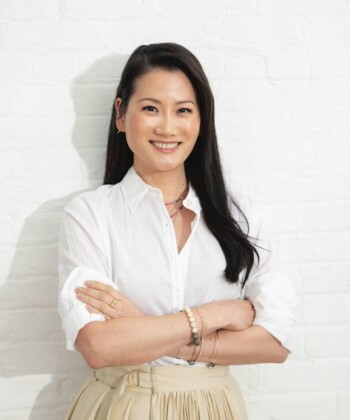On a recent Friday night, Laura and her friends gathered around a 22-seat farmhouse table on the back patio of a bungalow in Brentwood. It was just after 9 and the surface was littered with the telltale remnants of a good dinner party: casually just-so arrangements of white peonies, half a dozen empty bottles of Commanderie de Peyrassol, chatter about camps, holidays in Capri, what everyone was watching on Netflix. Then out came coffee and dessert.
Someone had brought chocolates. Laura placed them onto the table: nine delicate pieces each topped with an artful fold of dark chocolate and a sprinkling of sea salt (Maldon, naturally) and tucked into a small, fabric-lined box embossed with gold foil. Inside them, she announced, was caramel. Also: cannabis, each perfect square infused with 10 mg of THC.
“You need to meet my friend,” a coworker had told Laura a few years earlier of the chocolatier who’d made them, a former apprentice to Alice Waters who, she’d been told, had found a celebrity following with her underground line of high-end handmade, organic chocolates. Brilliant, she thought. It wasn’t like Laura was a pothead, she says, or even a regular smoker. She’d gone to college in Vermont, where, she says, “people smoked weed, but I wouldn’t say I was an avid user.” But after spending her 20s drinking in bars, her more civilized 30s drinking wine in nice restaurants or over at friends’—getting married, having kids, climbing the ranks at work and closing in on her 40s—there was just something just so appealing, so right, about weed. If it doubled as a classy hostess gift, one that everyone could enjoy, even better.
Over the last few years, marijuana has eased its way onto guest lists around L.A., shrugging off any hippie connotations to earn a place at the table alongside non-couch-surfing, non-binge-eating professionals who perhaps hadn’t thought about pot in years, if they’d ever thought about it much at all. Jess, who heads an educational nonprofit, says that she and her friends will even bring along a bag of gummy bears (the edible kind) to a night out at dinner for a “giggly good time.”
For one thing, as Jess points out, “Anyone can get a prescription.” Laura’s husband’s doctor recommended marijuana for his sleep issues, but, not yet an official U.S. citizen, her husband was wary of filling the script. So Laura got one instead, simple as that, joining the some 800,000 people in California, or about two percent of the population, who are licensed to receive medical marijuana prescriptions. Sales of medical marijuana in California hit $2.7 billion last year.

Shirt by Longchamp, Ring by De Grisogono. Rings and bracelets by Jennie kwon designs. Plates by Restoriation hardware.
For another, marijuana is both efficient and effective, something that Los Angeles type-A types can appreciate—a quick and guaranteed good time in the way rosé really isn’t. “I and a lot of the people in my peer group are at places in our lives where we’re very busy,” says Laura, a mom of two. “We have kids, careers, social lives, and everything needs to run as efficiently as the next.” The gummy bear and pot-infused chocolate part of the evening serves to amp things up on an abbreviated timetable, now that the nanny needs to be relieved by 11, the short sprints of parenthood and early middle age having officially replaced the 3 A.M. marathons of their 20s and early 30s. “If you’re going to take the time to go to, or to host, a dinner party, you want it to be as fun and interesting as possible, the best version of itself,” she says. “Getting stoned is a mini-bomb to throw into the evening to kick it up a notch and differentiate the night, and fast,” a social, collaborative, near-instant high. Or, as Jess describes it, “It’s like coke in the ’80s.”
Except, of course, without the comedown. Pairing wine with pot, in fact, makes hangovers, for the most part, a thing of the past—something these busy parents also enjoy. Even with the stronger strains that have accompanied the medical marijuana boom, pot offers a gentler, more manageable buzz than alcohol, while also countering its morning-after effects. “I can’t go out and have five gin and tonics and get up at 6:30 with my two kids—it’s too painful,” says Laura. “But certainly a couple glasses of wine and a gummy bear is a good combo.”
And, of course, a creative class of marijuana artisans, like the chocolatier, bubbling just beneath the surface of legalization doesn’t hurt, offering too an air of exclusivity and refinement—good taste all around. “A lot of times when you’re doing edibles, it’s like, I’m just going to grin and bear it and swallow this gummy bear and it will be fine, but some of this better stuff, like the chocolates, don’t taste like you’re eating pot,” Laura says. “It’s delicious. Plus, there’s some style to it.”
A measure to legalize marijuana for recreational use in California will appear on the ballot this November, and while states including Florida, Maine, Massachusetts and Nevada will also decide on marijuana-related ballot initiatives this fall, California’s Adult Use of Marijuana Act, or Proposition 64, is the most high-profile and far-reaching of the bunch, allowing adults to “possess and grow small quantities of cannabis for personal use,” while also establishing a regulatory framework for commercial production and for taxation of its sale. It will almost certainly pass: A February poll conducted by public policy research group Probolsky Research found that 60 percent of registered voters say that they will vote in November to “legalize marijuana for recreational use under California law.”
Both Jess and Lauren are part of friend groups that spend weekends throughout the winter in Aspen, where, since Colorado’s recreational legalization in 2014, pot has fully worked its way into the social scene. Upscale boutiques like Silverpeak Apothecary—“a fascinating education in the art and science of enjoying a superb cannabis experience,” according to its website—deal in plants, accessories and infused products, artfully displayed in glass cases and sold by highly educated, well-spoken staffers. “It’s weird,” says Jess. “But you might as well be in Cartier. You get used to the idea that pot is now high-end, or can be.”
Until now, people like the chocolatier have been secret resources, their existence shared mostly between friends and friends of friends. Although she has a beautiful website, the chocolatier tells me she’s holding off on press while she keeps an eye on legislation. In the meantime, she’s busy collecting advice from some of her high-powered clients, including Laura’s consultant husband, about how to position the business post-legalization. The wait, for many, is eager: Legalization is expected to raise state revenues by $1 billion in the first year alone, with a number of pot-related goods and services, from on-demand delivery to $600 “smart” vaporizers, lying in wait. Meanwhile, the price of land in the Southern California desert tripled after laws opened to permit commercial marijuana cultivation. There is, perhaps not surprisingly, such a thing now as a “cannabis lawyer.”
Jess is looking forward to legalization too, so long as her dinner parties will still feel special, of course. She recalls a recent birthday gathering for 14. “Everyone ate chocolate and it was the most fun,” she says. “We were hysterical the whole time.” By 10 P.M., the plates were cleared and by 11, she was washing her face and happily slipping beneath her duvet.










































